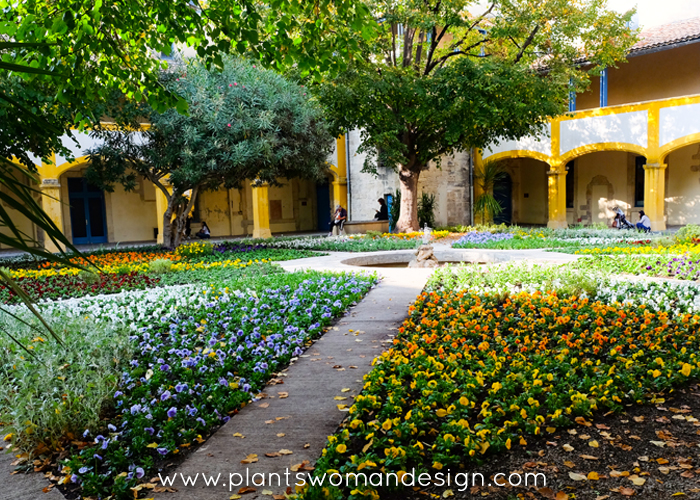
Traveling Plantswoman: Arles, France 2017


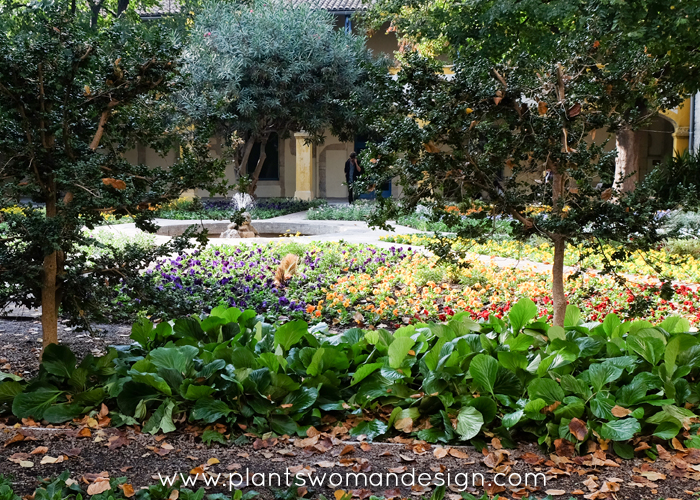






A long awaited vacation always provides opportunity for exploration of other types of scenery. I’m always look for new types of plants or in this case a new type of gardening.
This week I find myself at Zion National Park which has a diverse
collection of plant communities. I was surprised by the relative
lushness found in Zion Canyon. The riparian area of the Virgin River
supports enormous cottonwood trees and a diverse collection of
herbaceous plants and grasses. Nearby, saturated wetlands make nice
habitat for cattails, willows, aquatic plants, and rushes. Water seeping
out of the Navajo sandstone creates tranquil springs and the unique
“hanging gardens” for which Zion is famous, full of ferns, wildflowers,
and mosses.
Here I found many of the same species of wildflowers that I see in Washington forests. It was so amazing to see maidenhair ferns, columbine, and Indian paintbrush clinging to little crevices in the rocks with seemingly no soil just the nutrients from the water seeping from the rocks. It felt like it was raining but looking up into the clear blue sky it was obvious that the water was falling from the rock hundreds of feet above my head. The water in the Virgin River is a cloudy milky colored blue. Probably from the high mineral content of the water as the erosion of the cliffs continues.
Near the north end of the park on the Taylor Creek Trail I could see ponderosa pines high on the sandstone cliffs clinging to cracks and ledges. These massive trees push their powerful roots into the Navajo Sandstone, adding to the slow process of erosion that is constantly changing the face of Zion. The dusty trail lead through juniper and creosote brush interspersed with tiny wildflowers. Dropping into the river and walking through the water filled slot canyons kept us cool.
One of the most amazing things was to see Datura wrightii, or Devils Trumpet, growing wild. The large white flowers and blue green leaves look like the non-hardy tropical variety I overwinter each year in the green house. This one however is a Utah native that grows in the roadside ditches. The hardiness map says that the St George Area is 8a. It seems hard to believe it can grow here. Maybe a small thorny seed will find its way into my bag for the return trip. Don’t worry I’ll get it outside the park as taking any plant material from a National Park is illegal.
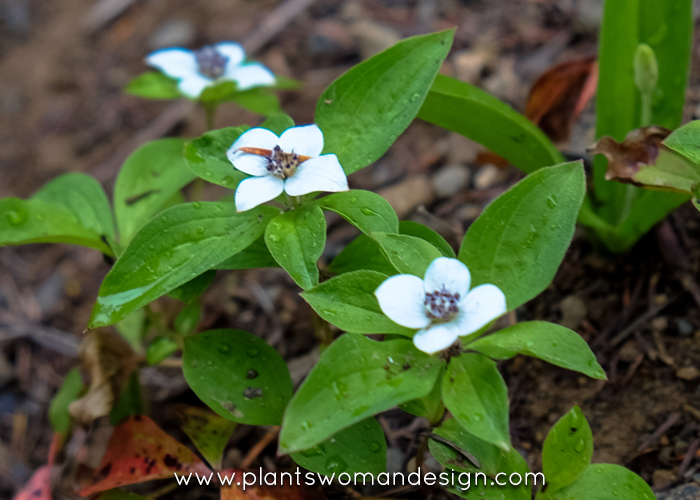
One of the main reasons I left an accounting career to do garden design was so I could be outdoors. At first gardening was just a way to be outdoors and still make a living. Now gardening has turned into a passion, not just a job. However, I still look for ways to get outside. This past weekend it was a trip to the Tubal Cain trail. I like to mix in my love of plants with my love of outdoors. Often I’m left behind while I stop over and over to check out a plant that caught my eye.
I was hoping to see some wildflowers but did think it was a little early to see much. I never expected to see the native rhododendron (Rhododendron macrophyllum) in such amazing beautiful color. The understory of much of the trail was completely covered in blooming Rhododendron. In different phases of bloom and different colors of pink, the blooms went from deep pink purple to light cotton candy pink.
Along the trail on the way up there were brilliant red columbine Aquilegia Formosa tucked into shady places. The scree (gravel washes) had Cornus Canadensis, Saxifraga and Clintona uniflora or queen’s cup growing along the edge of the trail. Frittilaria lancelota was up and solid green. The tip of the flower had been formed but was still small and the same color.
My goal was to get to the alpine meadow at the end of the trail. The long slope was flowering with early spring/summer flowers. Mountain phlox, lupine, campanula, penstemon and Thalictrum were just beginning to bloom showing soft subtle colors this early in the year. As the summer progresses their colors will change to more brilliant shades.
We sat down to eat our lunch on a rock next to the trail, turned around and were surprised to see the large form of Mt Buckthorn in front of us. Clouds were moving around it and the sun was playing with shadows and forms on the snow.
Turning around after 2 ½ hours we came back down the trail still looking for a coral root. I finally spotted this hardy orchid and tried to get a good picture but all of the photos came out poorly. This photo is from the Native Plant Society of Washington.
If you get a chance to take a walk, go now. The Rhododendrons will be blooming for a couple of weeks still and the variety of wildflowers blooming will just keep getting better. The trail is an easy 8 – 10 miles round trip with elevation gain of only 1000 feet over 4 miles. Take your camera, pack your lunch, and have beer in the cooler when you get back. That’s the way to hike.
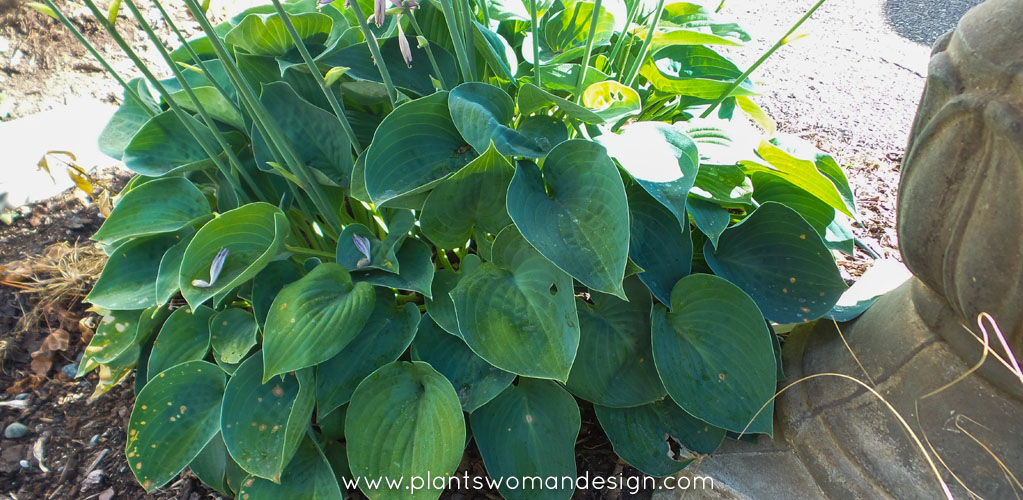
When I get a chance I love to travel, mostly following my kids around in their life adventures. Last week found me in Michigan and I became a little crazed while walking down the street. This is not all that unusual but can be embarrassing for the grandkids. They start tugging my hand and saying ‘It’s ok Gma, let’s go back’. Both in this little town and on the streets of Boston (another kid lives there), there are hostas everywhere! At least I think they are hostas, without the holes and slime it is hard to tell. These are not plants that are loved, cherished and watched constantly. They are growing around telephone poles, in abandoned gardens, around foundations of houses that haven’t seen a gardener in many years.
When I see plant inventories from Plant Delights, Naylor Creek, and other growers with hundreds of hosta varieties I’m always amazed that Hostas are popular at all. Here in Slugville (not the baseball kind), we are hosta challenged. Our dreams of beautiful tropical spears of leaves and wonderful flowers turn into nightmares. We plant, pick slugs, coddle, pick slugs, fertilize, pick slugs, spread slug killer (organic pet and wildlife friendly, if there is such a thing really), put collars around, (slugs crawl over duh), and put gravel mulch around. There is even the beer method where you get dead slimy slugs swimming in beer to dispose of. One gardener I know takes the morning paper out of the plastic bag and picks snails and slugs for the first hour of her day, EVERY DAY. Still the hostas here look like swiss cheese. The little precious baby ones with tiny leaves disappear overnight with out a trace left to mark its passing.
Why is that! Can we trade slugs for fireflies? How about a two for one, slugs and snails for fireflies. How about developing an insect, bird, or animal that loves to eat slugs while leaving the rest of the garden alone. Or maybe a slug that tastes like blueberries so the Robins will be fooled. Here are a couple of pictures of my hosta!
You can see the slug method of cultivation. This is with the pet friendly slug killer around them. Maybe slugs are really pets in disguise. The first photo in this post is one that I inherited with the house growing in an odd place, on an island surrounded by asphalt, planted with gravel and Agaves. That one is safe for the time being. Maybe someday the slugs will find away to get to it. They are sneaky like that.

The Plantswoman
Hello and welcome! I'm Susan, owner and principal designer of Plantswoman Design. When I'm not designing for others I'm in my own garden growing and experimenting with plants. I want to inspire everyone to grow something. So, join in the conversation and then let's get outside!
Plantswoman Design, Inc.
PO Box 10505 Bainbridge Island, WA 98110
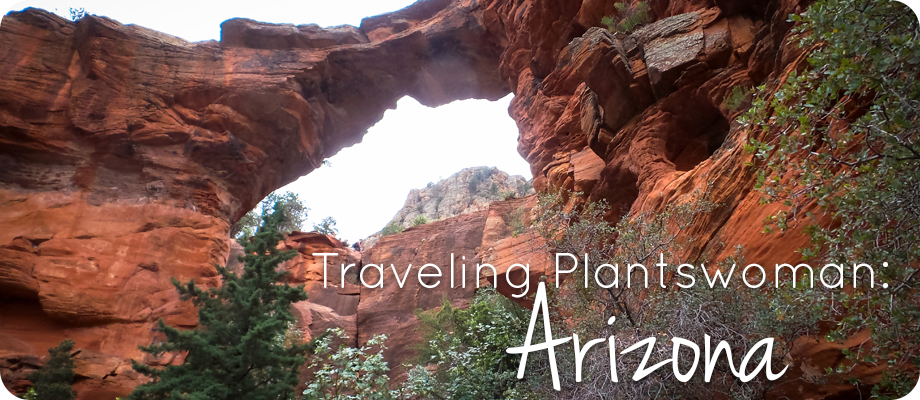
It’s nice to get away from the Pacific Northwest in the spring. Sometimes you can count on a beautiful Memorial Day but usually it will rain and this year was no exception. Lots of rain but not for me as I was in Phoenix visiting family, a great place to visit this time of year. Not hot yet, a mild 70 – 80 degrees, which is not hot even by our standards. Surrounded by friends and family, I usually force them into a visit to a botanical garden or other horticultural activity. This time I was content to go with the general votes as to activity and not force others into seemingly endless views of plants and flowers. We drove to Sedona and went on two great hikes. I was usually at the end of the line of 6 hurrying to catch up after taking pictures.
This May has seen a lot of rain in the Phoenix area as well. The hills surrounding the city are sage green instead of various shades of brown. The first day we hiked to Devil’s Bridge, which is a fascinating upper desert hike. Cactus, Oxanix, Yucca, were blooming as expected but what I did not expect was the amazing variety of wildflowers in the sand and gravel. The trail was dry and dusty but alongside were blooming daisy, pennstemon, grasses, yellow lineanara, a light purple thistle/centura, and MANY things I did not recognize. I stopped again and again taking pictures and will continue to do research on varieties found there. Some of them looked very similar to the New Zealand plants that are very popular in nurseries for our Mediterranean climate. Several trees, including varieties of Pines, and deciduous lovely green leaved trees lined the trail. But one of the standouts for me (hater of Juniper) was the colorful juniper with beautiful multi-colored bark. Looking similar to the Eucalyptus trees we found in Hawaii, I would have never expected to love them. The sage green coniferous foliage was a great contrast to the bark. It felt like I was walking through a botanical garden with a very natural design. The grasses massed together naturally and the bright spots of color stood out against the contrast of rocks and gravel.
Smooth, beautifully worn large pieces of sandstone were crossed and you could see were flash flooding or old streambeds created washes, and collections of rocks along the edges of the trail.
Air was fresh and scented with sages and the juniper. I know I’m writing mostly about the plants but the rock formation of Devil’s Bridge was amazing too.
After spending time in the dry desert of Sedona on one day we decided to visit the river the next. There is a lovely hike along the river, just a short distance away. The two areas could not have been more different. It was cooler, shaded, with an unexpected lushness. The plants were different with subtle color and texture. Ferns! Yes ferns growing under the larger trees.
The trail meanders along the river with 12 crossings with sandstone under foot was easy too walk on. If you happened to slip and fall in the water it just felt great. As we went up river the sides of the valley became steeper and the rock formations towered over us. A cool spot for a picnic lunch then back along the river back to the parking lot. Cool drinks awaited us when we got back to the cars. Such a great hike!
Interested in creating a more natural look and feel in your own garden? Take a look below.

The Plantswoman
Hello and welcome! I'm Susan, owner and principal designer of Plantswoman Design. When I'm not designing for others I'm in my own garden growing and experimenting with plants. I want to inspire everyone to grow something. So, join in the conversation and then let's get outside!
Plantswoman Design, Inc.
PO Box 10505 Bainbridge Island, WA 98110

Tis the season for hunting down your new favorite plants! I read a lot and communicate with people all over the world about plants and each year I usually find one I’ve been obsessed about finding. Many times they are plants I’ve killed and want to try again. Sometimes they are plants I see growing in someone else’s garden and wonder why I can’t have them in my garden too. Zone 8 plants are always iffy but I can’t resist trying them and talking about how to grow them with the grower.
The independent plant sellers have a way to help us plantaholics find our fix. They combine their efforts at regional plant shows and sales each year. Best thing ever!! This year my obsession was the Loquat Plant – Eriobotrya Japonica. This evergreen stunner is growing happily in Portland at the McMenamins Edgefield garden. It is lovely, tropical looking and luscious. I started doing research on where to find it. I found several places in Oregon but not mail order places. I couldn’t really justify a trip to Oregon for just one plant. But to visit a show, to see many, many different plants, to be excited about new plants I’ve not seen before… that I could do.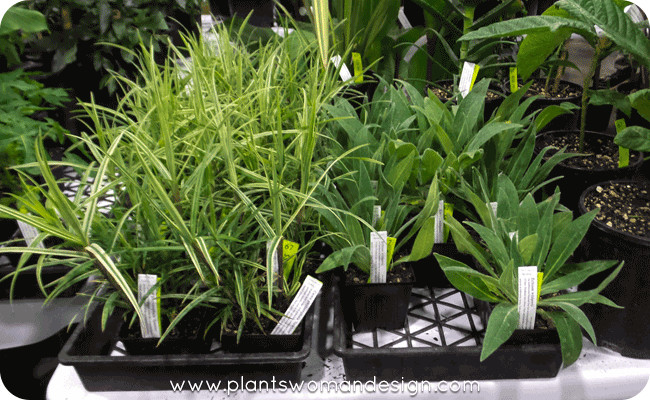
I contacted my friends at Cistus Nursery and they said they had a Loquat Plant I could grab while I was down there. So off I went to Hortlandia, a big horticultural show and sale in Portland. It was so amazing to see so many growers, so much plant material, so much knowledge and people so willing to share all in one place.
I was there just a few minutes and found the Eriobotrya Japonica. The grower was impressed that I knew what it was. But that is what an obsession is about… you know what you want, you see it in your dreams. I also got a fabulous hardy ginger, Hedychium greenii, Camassia leichtlinii ‘Sacajawea’ and several non hardy tropicals, including an aloe dorotheae, and alocasia ‘Regal Shield’.
My biggest problem always lies in how to get the bounty to my car after visiting all the fabulous growers. But the show makes it easy. You simply gather what you want, drop it off and they store it all until you were done shopping. After shopping you just take your little treasures to the check out tables where they ring up your order. After you finished there is a group of volunteer teens ready to move your take to an outside holding area while you get your car then help you load it! Amazing.
There are also several plant sales in my area to temp me. Heronswood had a sale in April and is open off and on through out the season. The Arboretum Foundation has FlorAbundance in April and FallAbundance in September. Independent nurseries bring their best plants to temp you. It is best to come early because the best things are gone fast! Here are a few things from my garden that I got last year.
Check out the plant sales in your area and keep purchasing from independent nurseries to keep the trade alive and new plants coming.
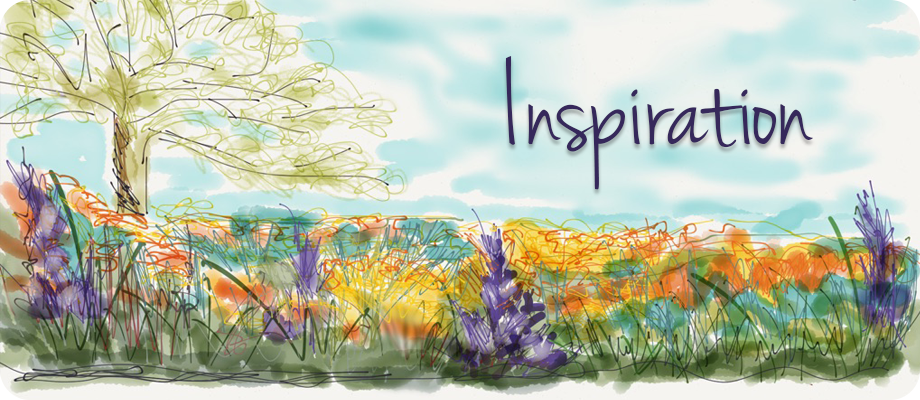
The sky was beautiful last night. First raspberry, changing into soft orange then fire red. I just wait, keep waiting… Bruised purple with dark gray tips. February is not usually this kind to us. As I look at the beautiful sky I think about the garden. I think about the soft oranges and yellows of spring. Primroses in colors of the sunset with the still dark gray of decayed birch leaves behind. Why do I think of the garden when I see the sky?
It is what inspires me.
Here are other things that inspire me right now.
A beautiful meadow planting by Adam Woodruff was featured in Fine Gardening Magazine’s February edition. You can take a look at the plant list of this amazing garden HERE.
The Red Butte Botanical Garden in Utah has a great children’s garden. Even in the winter time there was much to see, here’s what I found…
What inspires you? I’m so excited to plan, plant, and enjoy! Let the Gardening begin.

With the family in town we headed over to the Bellevue Botanical Garden’s annual Christmas light display D’Lights. The lights were really quite impressive with many critters and fun things to spot. There is still time to go see the lights until January 3rd, 4:30-9:30pm. Here’s a little peek from our visit! Let me know if you go and what your favorites were.